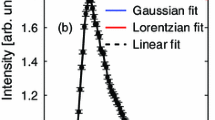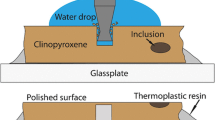Abstract
Electron spin resonance (ESR) spectroscopy is used to investigate the nature of exchange sites on kaolinite. ESR spectra of exchangeable Cu2+ and Mn2+ on kaolinite indicate that divalent exchange ions are about 11–12Å apart on kaolinite surfaces and that planar Cu (H2O) 2+4 ions are oriented parallel to the surfaces. Solution-like spectra for exchangeable Cu2+ and Mn2+ are observed at high relative humidities, suggesting a high degree of mobility of exchange cations on kaolinite surfaces. The evidence seems to eliminate edge sites as being active in cation exchange at least in the acidic range of pH. Similar conclusions are derived from ESR studies of Cu2+-saturated talc and pyrophyllite. It is proposed that most exchange sites arise from ionic substitutions or mineral impurities in phyllosilicates.
Similar content being viewed by others
References
Berkheiser, V. and Mortland, M. M. (1975) Variability in exchange ion position in smectite:dependence on inter-layer solvent: Clays & Clay Minerals 23. 404–410.
Bundy, W. M., Johns, W. D. and Murray, H. H. (1965) Interrelationships of physical and chemical properties of kaolinites: Clay Miner. Soc, 2nd meeting, p. 34.
Clementz, D. M., Mortland, M. M. and Pinnavaia, T. J. (1974) Properties of reduced charge montmorillonites: Hydrated Cu (II) ions as a spectroscopic probe: Clays & Clay Minerals 22, 49–57.
Clementz, D. M., Pinnavaia, T. J. and Mortland, M. M. (1973) Stereochemistry of hydrated copper (II) ions on the interlamellar surfaces of layer silicates. An electron spin resonance study: J. phys. Chem. 77, 196–200.
Grim, R. E. (1968) Clay Mineralogy, 2nd edition, p. 193: McGraw-Hill, New York.
Jones, J. P. E., Angel, B. R. and Hall, P. L. (1974) Electron spin resonance studies of doped synthetic kaolinite—II: Clay Minerals 10, 257–269.
McBride, M. B. and Mortland, M. M. (1974) Copper (II) interactions with montmorillonite: evidence from physical methods: Soil Sci. Soc. Am. Proc. 38, 408–415.
McBride, M- B., Pinnavaia, T. J. and Mortland, M. M. (1975) Electron spin relaxation and the mobility of manganese (II) exchange ions in smectites: Am. Miner. 60, 66–72.
Nicula, A., Stamires, D. and Turkevich, J. (1965) Paramagnetic resonance absorption of copper ions in porous crystals: J. Chem. Phys. 42, 3684–3692.
Sumner, M. E. (1963) Effect of iron oxides on positive and negative charges in clays and soils: Clay Minerals 5, 218–224.
Van der Marel, H. W. (1958) Quantitative analysis of kaolinite: J. Int. Etud. Argiles 1, 1–19.
Van Olphen, H. (1966) An Introduction to Clay Colloid Chemistry, pp. 71–72: Interscience Publishers, New York.
Weaver, C. E. and Pollard, L. D. (1973) The Chemistry of Clay Minerals, pp. 131–144: Elsevier Publishing Co., New York.
Author information
Authors and Affiliations
Rights and permissions
About this article
Cite this article
McBride, M.B. Origin and Position of Exchange Sites in Kaolinite: An ESR Study. Clays Clay Miner. 24, 88–92 (1976). https://doi.org/10.1346/CCMN.1976.0240207
Received:
Accepted:
Published:
Issue Date:
DOI: https://doi.org/10.1346/CCMN.1976.0240207




